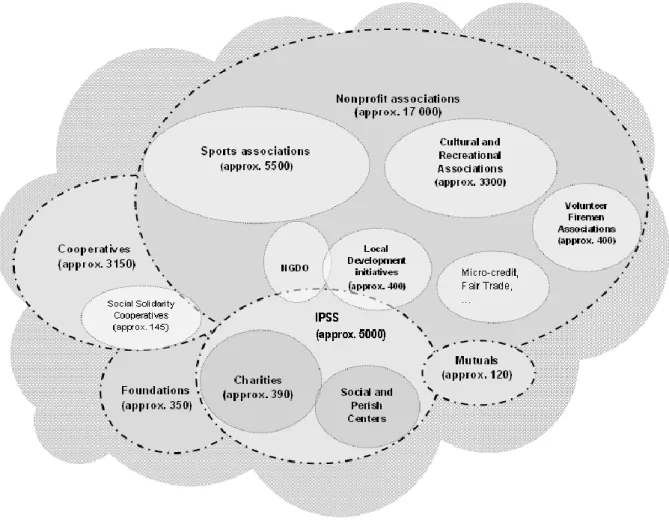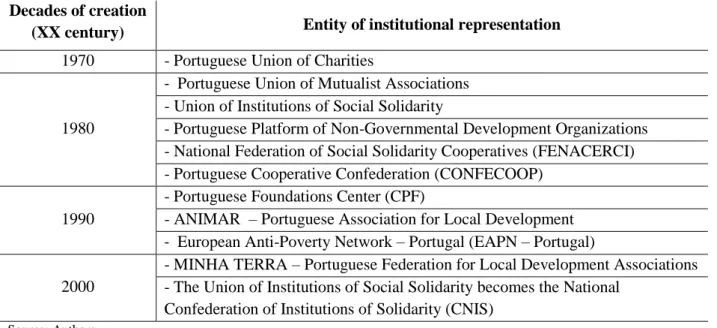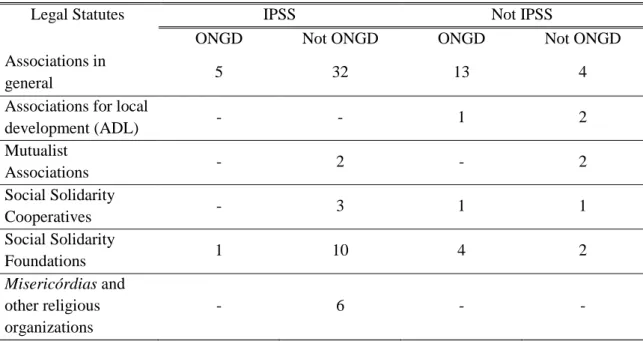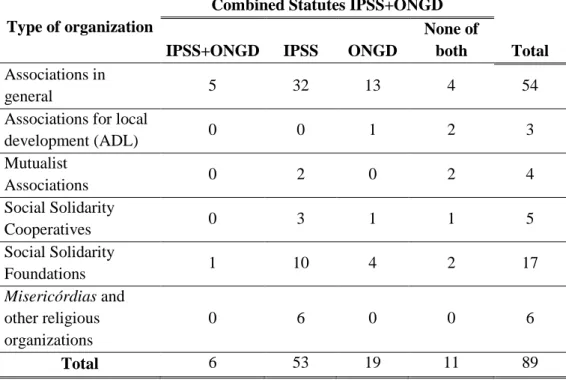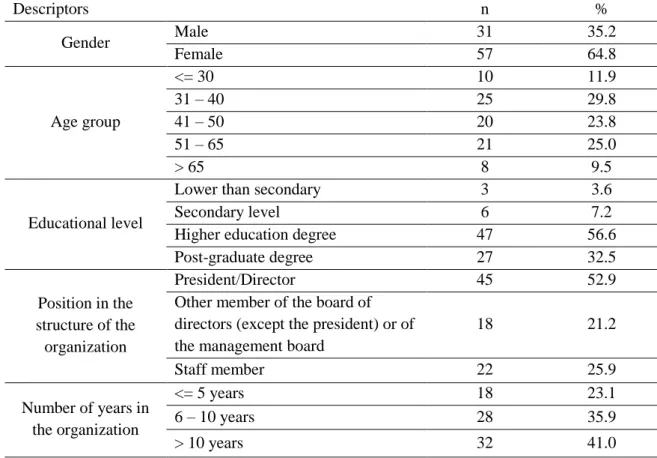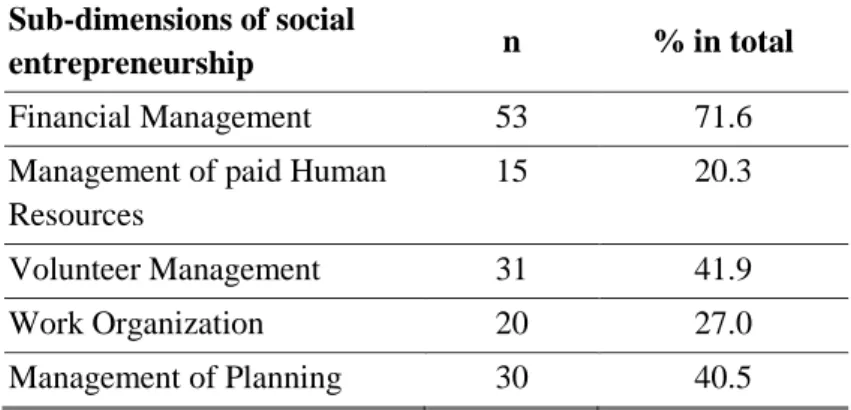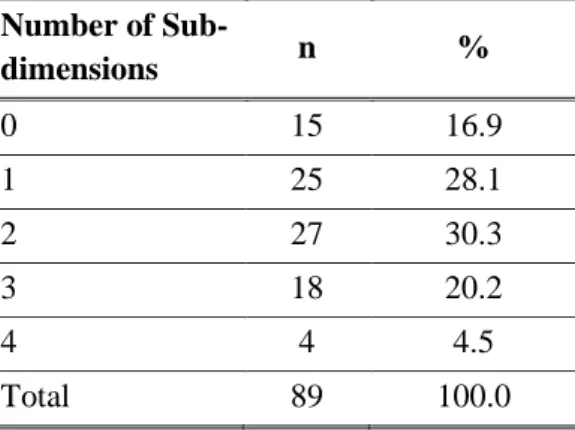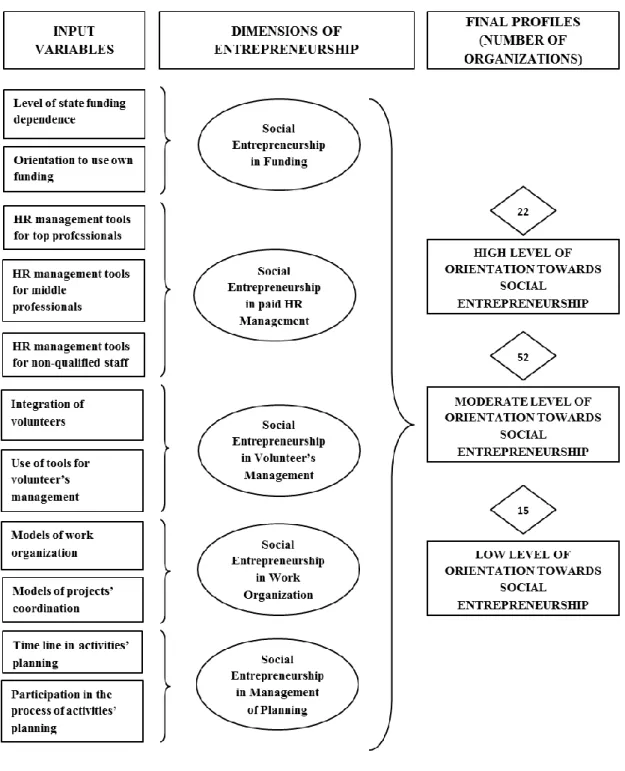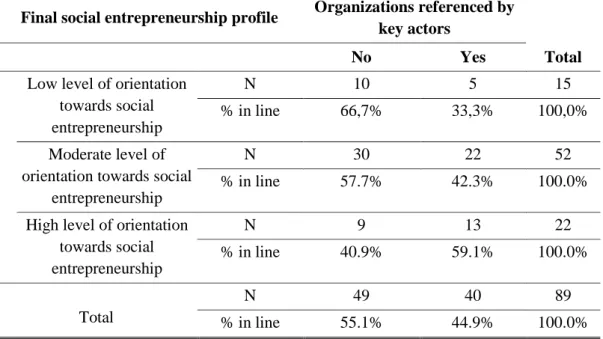DEFINING SOCIAL ENTREPRENEURSHIP:
LESSONS FROM PORTUGUESE
ORGANIZATIONAL DYNAMICS
Cristina Parente
Assistant Professor in Department of Sociology. Researcher at the Institute of Sociology. Faculty of Arts - University of Porto (ISFLUP/UP). E-mail: cparente@letras.up.pt
Alexandra Lopes
Assistant Professor in Department of Sociology. Researcher at the Institute of Sociology. Faculty of Arts - University of Porto (ISFLUP/UP). E-mail: aslopes@letras.up.pt
Vanessa Marcos
PhD student on a fellowship research program at the Institute of Sociology. Faculty of Arts – University of Porto (ISFLUP/UP). E-mail: vanessa.c.marcos@gail.com
Social Entrepreneurship in Portugal: the politics, the organizations and the education/training practices (PTDC/CS-SOC/100186/2008) E-mail: empresoc@gmail.com Web site: www.empsoc.net http://www.facebook.com/empsoc
Defining social entrepreneurship: lessons from Portuguese organizational
dynamics
Introduction
Social entrepreneurship is a relatively new topic of debate as it dates back to the 1990s, and it encompasses different theoretical approaches set forth by the North American, European and Latin American Schools of thought. Despite this theoretical diversity and the maturation stage fitting the concept there has been the attempt of establishing an appropriate combination among the principles and values inherent to third sector organizations and the management mechanisms and instruments commonly associated to the private and for-profit sector.
This new relationship aims at promoting among these organizations a working rationale based on the principles of innovation and sustainability as opposed to the welfare logic of traditional institutions and financial State dependence practices. In Europe, social entrepreneurship as a theoretical field of research encompasses distinct representations and practices (Defourny & Nyssens, 2010a).
The need faced by organizations to tackle the challenges imposed by the Welfare crisis, the rise of unemployment and the emergence of new phenomena of poverty and social exclusion, have led the European tradition to focus its analysis on the concept of social economy. This term is applied to a relatively independent and equidistant sector from the public and private sectors in response to economic and social needs and is named by many as third sector (Ferreira cited by Cattani, Laville, Gaiger et al., 2009).
In Portugal, as well as in Europe in general, the concept of social entrepreneurship is intrinsically associated to the role of the Welfare State and moreover to the retrenchment of welfare state policies and mechanisms in the provision of social products and services. Different types of national and sectorial policies and particularly the budget restrictions are examples of the incapacity and inadequacy of governmental institutions to solve social problems, which has fostered to some extent initiatives from civil society groups and institutions in finding new practices capable of meeting social needs not covered either by the State or by the market. Although, these answers were traditionally based upon the North American nonprofit sector, in the European social economy or in the broad tradition of third sector, the social entrepreneurship process and practices seek to incorporate business concepts and ideas as a sustainability path to overcome the new social challenges. In this domain the School of solidarity economy with francophone origins and with a recent strong rooting in the Latin-American and semi-peripheral European countries (Gaiger & Corrêa, 2011) assumes a relevant role in seeking new institutional solutions to interlock both efficiency and economic viability
components (more managerial nature) and self-management and cooperation components (more political and social nature) (Laville, 2009).
Firstly, we present the theoretical framework enclosing social entrepreneurship in order to outline the different schools of thought and to reflect on its empirical application to third sector organizations in Portugal. Secondly, we characterize the Portuguese third sector regarding the diversity of legal forms and statutes it entails. Subsequently we expose the methodology of our study and discuss the results of the analysis highlighting the more significant trends of social entrepreneurship in third sector organizations working on the social field in Portugal.
1. From the concept of social entrepreneurship to its theoretical and empirical application in the Portuguese third sector
A diversity of conceptual approaches of social entrepreneurship have emerged since 1990s, some more influenced by the North American school, others by the schools of thought that have developed in the European context (Young, 2006); still others more aligned with the Latin American tradition (Gaiger & Corrêa, 2011). Our purpose was to acknowledge these approaches and to keep its heuristic aspects to the analysis of the Portuguese reality. Hence, we have adopted the broad concept of third sector in our research project entitled “Social Entrepreneurship in Portugal: the policies, the organizations and the education/training practices”. This paper is part of this ongoing research project that addresses the specific nature of social entrepreneurship initiatives among third sector organizations in Portugal.
Moreover, it consigns the social organizations under analysis to this empirical field of research, therefore theoretically and ideologically refusing the inclusion in the social entrepreneurship concept of private or public organizations or the actions carried out by these actors.
Our option to circumscribe the analytical field of the study to the third sector can be explained both by theoretical and empirical reasons. In what concerns the first dimension we subscribe to the European Research Network (EMES)1 concept of social enterprise as it frames the heterogeneous reality of national social organizations.
It can also be explained by the fact that it is rooted on a European theoretical perspective which emphasizes a strong connection between the State and the Third Sector from which we do not intend to detach.
1
EMES are the initials of Emergence des Enterprises Sociales en Europe or Emergence of Social Enterprises in Europe. At first, it was the title of a broad research project carried out from 1996 till 2000 by a set of researchers who constituted afterwards the EMES network. When the network decided to become a formal international association kept the initials and began to carry out other research projects focused on social enterprises and, more broadly, on the third sector. Currently, EMES encloses ten university research centers as well as individual researchers specialized in these fields of research from all over Europe.
According to the definition of EMES, social enterprises are private organizations which provide products and services with the explicit purpose of benefiting the community. This type of organizations are held and managed by a group of citizens and are specifically structured to exclude profit as the main goal as well as revenue distribution among members which cannot, with one or other exception, take place (Borzaga, Galera & Nogales, 2008).
Taking as a starting point this delimitation of the concept, the European school of thought has been particularly focused on the objectives of these organizations as well as on their management principles. In other words, internal and external organizational mechanisms are conceptualized according to a strategy of participatory management and of orientation towards stakeholders’ involvement to ensure meeting the social goals (Defourny & Borzaga, 2001; Spear, 2006; Defourny & Nyssens, 2010a).
EMES sets forth nine criteria to help defining its economic and social characteristics (Defourny, 2001; Defourny & Nyssens, 2010b). A social enterprise perceived as an organizational axis of social entrepreneurship should have the following economic features: (a) a continuous activity of products and/or service provision; (b) a high degree of independence regarding public or private bodies; (c) a significant level of economic risk leading its financial viability to depend from the capacity of its members and workers to ensure the appropriate resources; (d) a minimum quantity of paid work apart from the activities carried out by volunteers. The social dimension of social enterprises should encompass the following criteria: (a) to have the specific goal of benefiting the community or a specific group of people; (b) to be voluntarily created by a group of citizens and take a collective dimension despite the important role of leaders; (c) to promote a decision-making process based on the principle ‘one member, one vote’; (d) to be based upon stakeholders’2 participation and involvement; (e) to have a limited distribution of profits therefore enhancing the primacy of social goals.
It is this organizational and management configuration that is gradually under discussion as it directly impacts on the processes and mechanisms these organizations undertake to solve the social and economic needs which characterize contemporary societies. To promote its theoretical understanding we have decided to use an analytical framework that is inspired by the several schools of thought namely:
1. From the Social Innovation School perspective of social entrepreneurship we highlight the creation of social value as a result of using innovative approaches in a context of scarcity of resources. Underlying this reading is the empowerment of communities, the social impact and the drive to change, as well as the scale of reproduction and the sustainability of
2
By stakeholders we have considered the individuals, groups or organizations that are directly or indirectly as well as emotionally and/or resourcefully involved in the activities of the organization. In this concept we have included clients/users, beneficiaries, paid workers, volunteers, and interns, board of directors, members, partnerships, donors, funders, trustees, and suppliers, regulating bodies, trade unions, public sector, local community and community in general.
initiatives. Social entrepreneurs and their intrinsic personal qualities take a crucial importance in this approach, particularly with authors such as Dees (1998), Bornstein (2007) or Mulgan (2007);
2. From the Management school (Business School or Earned Income School of Thought3) we emphasize the market-driven management that translates into the use of strategic planning. Sustainability, in that sense, is seen as coming primarily from the development of commercial activities that provide the necessary resources to pursue the social goals of the non-profit sector (Boschee & McLurg, 2003);
3. From the European social economy school approach, we keep the accent in the normative dimension of the organizations. This is shared, to a large extent, by the Latin American school and the European semi-periphery proposals, and translates into the definition of a set of principles regarding the internal structure of organizations: (i) serving the community and not the capital; (ii) pursuing a management model that is independent from both public and private actors; (iii) enforcing democratic approaches to the decision-making process; (iv) giving priority to people and labor in income distribution. The European approach clearly highlights the organizational mechanisms that create the conditions for participation and strategic planning in management to achieve social goals (Defourny & Borzaga, 2001; Spear, 2006; Defourny & Nyssens, 2010b). This is also the meaning given to solidarity entrepreneurship by the Latin American school of solidarity economy. The Network of Latin American Researchers of Social and Solidarity Economy (RILESS) often uses the term “the other economy”, based on the principles of the European cooperatives movement and pioneer from the XIX century (especially self-management) and on the development of a culture of solidarity (Souza, 2010). The heuristic value of the different theoretical proposals is largely defined by their capacity to analyze the empirical reality taken into account.
The delimitation of the empirical object of our research study implied the analysis of social entrepreneurship taking place in third sector organizations operating in Portugal in the broad field of social issues. The unit of analysis is the social organization which resumes the approach focused on the entrepreneur. Our option is explained by the fact that we consider that the individual perspective of social entrepreneurs has an influence on the organizations where they work and the later reflect their leaders’ characteristics, particularly regarding the organizational management and leadership models. Also, because we are convinced that social entrepreneurship reaches its true impact of social transformation both socially and economically and on an endogenous level by practicing the principles of organizational citizenship, when taking it account the collective and organizational perspective.
3
Our approach to social entrepreneurship is molded in the confluence of this diversity of schools of thought. Our goal was to define social entrepreneurship profiles in the third sector organizations in Portugal through the analysis of internal organizational variables. Our classification of the variables is the following: (i) management models (financial resources and human resources management); (ii) models of work organization, leadership and team work; iii) governance and accountability. This last set of variables ended up not showing any applicability in the sample of surveyed organizations and was eliminated from the identification process of social entrepreneurship profiles in the organizations. On the basis of this typology we have taken onboard a set of theoretical presuppositions indicating a positive orientation towards social entrepreneurship, namely: (i) to reach for diversified funding sources and alternative to State funding; (ii) to promote an integrated management of both paid human resources and volunteers; (iii) to stand for a strategic orientation and to apply planning tools based on participation models; (iv) to adopt control and coordination of work models that are based on team work and on the delegation of responsibilities.
2. Third sector in Portugal
The scarce number of scientific studies about the third sector in Portugal, the lack of national statistics on the sector and the consequent limited understanding of its working rationale, alongside its heterogeneous legal forms as well as organizational and management structures partially justify the fragile identity of the sector.
In addition, the dispersion of Portuguese legislation about the third sector, the lack of adjustment of the organizations’ legal forms and status and the internal diversity of the sector reflected in the different family groups it encompasses, raise difficulties in their organizational performance and especially for the consolidation of the sector.
This sector of activity includes three major legal forms: associations (such as Mutualist Associations), cooperatives and foundations (Chaves & Monzón-Campos, 2008; Perista, 2001; Hespanha, 2000; Parente, 2011; Quintão, 2011; Carvalho, 2010) which represent a diversified organizational and management structure.
Figure 1 depicts a rough outline of the organizational diversity of the sector: it is an estimate (Quintão, 2011) due to the lack of a single and precise source that quantifies the existing number of organizations by subsectors or families composing the field of activity. The fact that the data collected are based on different and fragmented quantitative sources (which do not apply any common classification criteria) imposes some limitations to the identification of characteristics of this sector of activity in general and raises difficulties when attempting to measure the sector’s economic value as well as its trends within the national economy.
Figure 1 – The third sector in Portugal: an overview
Source: Quintão, 2011.
The end of the Portuguese dictatorship regime which lasted from 1933 to 1974 gave rise in the following decades and particularly in the 1980s to the emergence of a significant number of organizations and social movements. Between 1997 and 2007 the Portuguese third sector displayed a significant growth reflected both in terms of the number of organizations (90%) and of human resources mobilized (85%) (Carvalho, 2010). The sector’s renewal was characterized by the emergence of new organizations under diverse legal frameworks and by the creation of representative governing bodies (Quintão, 2011).
These governing bodies whose date of creation we depict in Table 1 strive mostly for the political recognition of the work carried out by the organizations that they represent as well as for setting the needs and challenges across the sector in the public agenda.
Table 1 – Time line regarding the creation of some governing bodies within the Portuguese third sector
Decades of creation
(XX century) Entity of institutional representation
1970 - Portuguese Union of Charities
1980
- Portuguese Union of Mutualist Associations - Union of Institutions of Social Solidarity
- Portuguese Platform of Non-Governmental Development Organizations - National Federation of Social Solidarity Cooperatives (FENACERCI) - Portuguese Cooperative Confederation (CONFECOOP)
1990
- Portuguese Foundations Center (CPF)
- ANIMAR – Portuguese Association for Local Development - European Anti-Poverty Network – Portugal (EAPN – Portugal)
2000
- MINHA TERRA – Portuguese Federation for Local Development Associations - The Union of Institutions of Social Solidarity becomes the National
Confederation of Institutions of Solidarity (CNIS) Source: Authors.
In 2010 António Sérgio Cooperative for Social Economy (CASES) was created as the public representative of the third sector and encompasses, among others, some of the governing bodies mentioned in Table 1 such as ANIMAR, CNIS, CONFECOOP, the Portuguese Union of Charities and the Portuguese Union of Mutualist Associations. It is interesting to note that CASES is not included by the Portuguese Platform of Non-Governmental Development Organizations and by the Portuguese Foundations Center but these are sectorial organizations which compose the social sector and represent therefore two of the families surveyed in our research study, namely the Non-Governmental Development Organizations (ONGD) and the Social Solidarity Foundations.
Even though these are representative of specific legal forms and present a diverse organizational and management configuration, both within the same family and intra-third sector, these entities embrace the principles of social economy being therefore distinctive from the working rationale of the market and of the State. The emergence of these governing bodies reflects both the significant increase of the number of organizations within the sector and their renovation particularly regarding the organizational structures and the management processes. Some of these are in accordance to what we considered to be social entrepreneurship practices.
Nevertheless, this recent trend contrasts with a highly dependent sector on public funding, characterized by a still dominant role of religious and social assistance organizations, the need for qualification and professionalization of the sector and the weak level of dynamism of civil society and of collective action in a sector that remains highly fragmented (Franco et al, 2005).
3. Considerations on the research method and on the construction of social entrepreneurship profiles
The empirical data that supports the discussion presented in this paper was generated by a survey study carried out between May and August 2011. It involved the use of a structured questionnaire in face-to-face interviews to managers or someone with an equivalent mandate in the sampled organizations. Nonproportional quota sampling was used to sample organizations from available databases4.
The dimension of the final sample was much more limited by constrains stemming from the project’s budget and less related to mathematics or statistical reasons, which explains the final number of surveyed organizations (89). The main challenge in our methodological approach was to decide the specific theoretical criteria on which to base the quota as it is intrinsically related to some of the structuring theoretical axis: the legal form and statutes.
The legal form of an organization (e.g. Association, cooperative, foundation) is a necessary but not a sufficient condition to obtain one of the three legal statutes for the sector in Portugal. Taking into account the organizations’ mission and vocation, these legal statutes allow them to benefit from tax exemption, to establish cooperation agreements with Social Security, to raise donations, to use the patronage law, to have special conditions for credit access or technical support, among others. Regarding the statutes there are three: the Statute of the Private Institutions for Social Solidarity (IPSS), Non-Governmental Organizations of Cooperation for Development (ONGD) and Non-Governmental Organizations for the Environment (ONGA)5 and the Public Utility Statute. Once registered, IPSS acquire the Public Utility Statute which enables them to have benefits from the State (tax exemption, financial support) and obligations (accountability, the obligation to cooperate with Public Administration). In what concerns
4
Our sampling database includes data we have crossed from two national governing bodies databases (CASES and the Portuguese Platform of Non-Governmental Development Organizations) as well as data obtained from sectorial governing bodies that were registered as operating in the social field of activity at the end of December 2011.When the information was not made available by the sectorial governing bodies we have searched the respective database on their specific websites. We have gathered in a single sampling database 1890 organizations whose primary sources were Social Security database regarding the Mutualist Associations (national level); IPSS’ database; Misericórdias’ own database; Portuguese Foundations Center own database; Database of the Associations for local development provided by the Portuguese Federation for Local Development Associations and by ANIMAR – Portuguese Association for Local Development; Cooperatives’ database provided by CONFECOOP and FENACERCI; Portuguese Platform of Non-Governmental Development Organizations’ database. The main challenge in the construction of our sampling database was to gather valid and credible information on the IPSS and ONGD Statutes and on the legal forms of the organizations (Mutualist Associations, Associations for local development and Associations in general; Foundations of Social Solidarity, Misericórdias, Social Solidarity and multi-sectorial Cooperatives) as they overlap, resulting on incorrect classifications by the organizations themselves. From a scientific point of view and as criteria on which to base the quota we have considered them as distinctive variables. However, the register at the governing bodies showed us that some organizations define their identity by the legal form and others by their Statute.
5
In this project we have limited our analysis to ONGD as we focused on organizations that work on the social field of activity.
ONGD, the Public Utility Statute is automatically acquired and exempts them from registering and from other obligations defined in the law for that purpose.
Sampling categories therefore included a combination of the following: (1) legal classification; (2) status in the dichotomy IPSS/not IPSS and (3) status in the dichotomy ONGD/not ONGD. Additionally, organizations were primarily selected from the list of organizations that had been previously signaled as examples of social entrepreneurship, either by their peers or by some organizations of reference within the sector. One of the main goals of the sampling methodology and specifically the construction of nonproportional quota sampling was to make sure we would have a sufficient number of organizational profiles which could have been excluded if applying the proportionality principle. In our study we were particularly concerned with specifying a minimum number of sampled units in each category rather than with having numbers that match the proportions in the population.
Finally, the selection also took into account the geographical proximity to the research team’s base as well as financial constraints and the need to contain costs associated to field work. Nevertheless, we covered almost all the national regions (NUT 2), with the exception of Algarve. The final sample comprised 89 organizations, all successfully included in the survey. The sampling quotas are described in table 2 below. The empty cells represent combinations of criteria that do not exist in the quota sampling database or are very rarely found in the population, even considering nonproportional representation.
Table 2 – Sampling quotas
Legal Statutes IPSS Not IPSS
ONGD Not ONGD ONGD Not ONGD
Associations in
general 5 32 13 4
Associations for local
development (ADL) - - 1 2 Mutualist Associations - 2 - 2 Social Solidarity Cooperatives - 3 1 1 Social Solidarity Foundations 1 10 4 2 Misericórdias and other religious organizations - 6 - -
When proceeding to a combined approach of the different legal forms and statutes previously taken into account, it should be noted the diversity of profiles included in the surveyed organizations database. This diversity raised difficulties when trying to determine some significant impacts on multivariate approaches.
Table 3 below depicts the combination of the legal forms and statutes of the surveyed organizations.
Table 3 – Distribution of the surveyed organizations according to their legal forms and statutes
Type of organization
Combined Statutes IPSS+ONGD
Total
IPSS+ONGD IPSS ONGD
None of both
Associations in
general 5 32 13 4 54
Associations for local
development (ADL) 0 0 1 2 3 Mutualist Associations 0 2 0 2 4 Social Solidarity Cooperatives 0 3 1 1 5 Social Solidarity Foundations 1 10 4 2 17 Misericórdias and other religious organizations 0 6 0 0 6 Total 6 53 19 11 89
The questionnaire was answered preferably by the director/president, even though in some organizations the respondent had a different role in the organization.
The respondents comprise heterogeneous socio-demographic profiles as it can be depicted from Table 4 which summarizes the main characteristics of the 89 respondents.
Table 4 - Characterizing features of respondents* Descriptors n % Gender Male 31 35.2 Female 57 64.8 Age group <= 30 10 11.9 31 – 40 25 29.8 41 – 50 20 23.8 51 – 65 21 25.0 > 65 8 9.5 Educational level
Lower than secondary 3 3.6
Secondary level 6 7.2
Higher education degree 47 56.6
Post-graduate degree 27 32.5
Position in the structure of the organization
President/Director 45 52.9
Other member of the board of directors (except the president) or of the management board
18 21.2 Staff member 22 25.9 Number of years in the organization <= 5 years 18 23.1 6 – 10 years 28 35.9 > 10 years 32 41.0
* The total sum within each descriptor is not always 89 given the fact that there were some missing cases in each variable. The distribution of these missing cases is random and occurs in different variables.
3.1. The definition of social entrepreneurship profiles
Generally speaking and in technical terms, the exercise of defining social entrepreneurship profiles involved a combined multivariate analysis (with the use of hierarchical cluster analysis and of the simple correspondence analysis as exploratory techniques) but it mainly relied in a set of theoretical options that were previously presented and that ultimately frame the reliability of the final result obtained. In addition, it is important to note that the purpose of this exercise was not to close down the classification of the organizations regarding their higher or lower orientation towards social entrepreneurship but rather to find a summary profile which is being further explored in the case studies.
The strategy for data analysis has privileged the analytical dimensions consigned to the internal processes of the organization. In the analytical model these dimensions represent the models of management and work organization. Due to the lack of empirical importance (poor quality of data especially caused by many missing cases, doubts regarding the validity of data in terms of measurement, the scarcity of information collected taking into account the low number of valid cases in all the indicators) some indicators of the mentioned dimensions were excluded such as
governance and accountability. We have selected the indicators of the following analytical dimensions:
i) Dimension of management models
In this analytical dimension we have worked with two axis of empirical operationalization. We have tried to isolate the organization activities’ funding profile which is one of the indicators of the financial resources management sub-dimension. Based on this indicator the purpose was to determine the presence/absence of social entrepreneurship features in the search for funding sources alternative to state funding. Thus, we have based our analysis in the assumption that the adoption of this working rationale in the organization reflects the organization’s efforts to find its self-sustainability.
This dimension is based upon an original variable which encloses the respondents’ answers regarding the identification of the organization’s activities funding sources. Taking this into account an intermediate variable was created which qualified each funding profile in terms of what theoretically represents in relation to social entrepreneurship. Such variable was developed according to a progression gradient which indicates a higher or lower orientation towards social entrepreneurship (State dependent organizations and without commercial orientation; organizations with State funding and an institutional diversity of funding; organizations with State funding and commercial orientation; organizations with commercial orientation and without State funding).
The second empirical axis involved the analysis of the sub-dimension regarding human resources management. This dimension of analysis was divided in two sets of variables: those directly related to volunteers’ management which also entails social capital management, and those related to the management of paid human resources. These indicators enabled signaling the presence/absence of entrepreneurship on the basis of the observation of a higher or lower integrated management of each of the two groups of staff in the organization considering the management practices and tools applied.
The analysis of the volunteers’ management was decided upon the existence of a Volunteering plan as a management tool. The analysis of the management of paid human resources was based on the tools of human resources management applied by the organization. In what concerns the management of volunteers we have worked with the following combined analysis: has/does not have volunteers and has/does not have Volunteering Plan. Taking these into account we have created an intermediate variable converted to a progression gradient of higher or lower orientation towards social entrepreneurship (without volunteers; with volunteers and without a volunteering plan; with volunteers and with a volunteering plan).
Regarding paid human resources management we have worked with a set of original indicators each one divided for 3 categories of workers, namely: top professionals, middle professionals
and non-qualified staff. These indicators captured the presence/absence of a diversified set of human resources management tools.
Simple correspondence analysis ran on the variables related to human resources management tools enabled us to isolate 3 sub-groups of tools in the organizations under analysis: tools related to work integration (job description and analysis, diagnostics of training requirements, work meetings and interpersonal communication, workers’ welcoming and integration); tools for performance (recruiting and selection, performance evaluation); tools with an orientation towards career and professional development (career management, training and professional development, drop-out management).
Taking into account these three dimensions we have derived intermediate variables, one for each group of workers, and converted each to a binary system of classification (strategic orientation/ non-strategic orientation in human resources management). This was obtained through the identification of the highest score signaled in the set of the three dimensions of human resources management for each group of workers.
Our interpretation was that the use of tools that mainly follow an orientation towards integration and performance entails an immediate and function-driven human resources management. On the contrary, the tools with an orientation towards career development reflect a developmental and strategic nature. The first presuppose a lower strategic orientation regarding human resources management.
ii) Dimension of work organization
We have also worked with two sub-dimensions in this dimension. We have privileged the organizations’ activities management having therefore analyzed the planning of activities both in terms of the orientation towards a higher or lower strategic planning in accordance with the timeline, and in terms of the models of participation in the planning process.
Based on a set of original variables which have given us information about the existence of plans of activities but also on the execution, monitoring, control and evaluation modalities of activities we have derived two intermediate variables. We have sought to identify the higher or lower strategic orientation regarding the timeline of the planning of activities. We have taken into consideration the strategic planning indicators elaborated for a 3 or more years’ timeline. The remaining were perceived as indicators of a more operational nature. We have applied this terminology to classify the organizations (strategic planning/ operational planning).
The second intermediate variable tried to identify levels of involvement/ participation in the planning of activities which was therefore converted to a progression gradient indicating a higher orientation towards social entrepreneurship, respectively: centralization of the planning in the board of directors and/or management board; moderate participation in the planning when
involving professionals with a leadership position; expanded participation in planning when it cumulatively involved professionals with and without a leadership position, middle professionals and/or volunteers.
Regarding the second sub-dimension we have crossed the analysis of the work organization with leadership roles. We have worked with the indicators of control and coordination models with higher or lower level of centralization and with higher or lower level of independence of the management board in relation to the board of directors as well as of the other members of the organization in relation to the management board. Thus, we have carried out two types of analysis. We have created an intermediate variable which has classified the organization regarding the type of work coordination mechanisms it uses.
This was obtained on the basis of a set of original variables which identified the work coordination mechanisms used by the organizations. It led to a progression gradient indicating the higher or lower orientation towards social entrepreneurship regarding leadership roles, respectively: a centralizing model in what concerns organizations which have signaled centralized mechanisms of supervision and control; an intermediate model in the case of organizations which combine the previous modality with decentralization categories such as delegation of responsibilities and control by objectives; delegation model which characterizes organizations that have signaled coordination mechanisms by delegation without signaling any mechanisms of direct our centralized supervision.
Finally, a second type of analysis regarding the dimension of work organization focused on the indicators related to the projects’ coordination modalities, once again related to the leadership roles. Our purpose with this analysis was to identify the higher or lower nature of the delegation modalities regarding projects’ coordination applied to top professionals in relation to the board of directors. We have converted the intermediate variable created to a progression gradient indicating a higher or lower orientation towards social entrepreneurship with the following scale: centralization in the board; centralization in the top professionals; decentralization.
Summarizing the findings, and based in these two dimensions, management models and work organization, we have derived a binary system of yes/no variables to the sub-dimensions of classification regarding the orientation towards social entrepreneurship. In the sub-dimension related to the funding models, we have classified as entrepreneurial the organizations that use State funding but with institutional diversification of funding, with a commercial orientation or those that do not have State funding.
In what concerns the sub-dimension of volunteer’s management the same binary classifies all the organizations which previously signaled having volunteers and a volunteering plan as reflecting an orientation towards social entrepreneurship.
Regarding the sub-dimension of paid human resources management, the presence of strategic management in one of the three groups of workers was enough to classify the organization with an orientation towards social entrepreneurship. In this case, we draw on the assumption that the organizations using management tools with an orientation to career and professional development, even if just for a specific working group, shall be applying on the other working groups tools that go beyond the straightforward orientation to working integration and/or to performance. That denotes a trend towards an advanced human resources management considering the rare observation of these practices and the characteristics of the organizations under analysis.
The sub-dimension related to management of planning involved a broader combination of possibilities in which the binary signaled the organizations previously classified regarding the participation of the organization members in the planning process with an orientation towards social entrepreneurship. Under this profile we have also considered the organizations that even though not defining a strategic plan of action were classified as organizations with expanded participation in the planning process, i.e. when top professionals, middle professionals and/or volunteers are cumulatively involved in the planning of activities.
This option is based on the assumption that the moderate or expanded participation of several internal stakeholders in the planning process may represent a more weighed and conscious decision-making process for the organization’s future than the time line (medium or long-term), once again due to the scarce number of cases where these practices were observed and the characteristics of the organizations under analysis. Finally and in what concerns the work organization sub-dimension, we have considered the organizations previously classified as cumulatively applying delegation and decentralization models of work organization and projects’ coordination as denoting an orientation towards social entrepreneurship.
3.2. Exploring the Social Entrepreneurship Sub-Dimensions
After the data combination exercise the first conclusion we have withdrawn refers to the considerable variation in the contingents of the different sub-dimensions of social entrepreneurship. From the table below we realize that there is a higher number of organizations in the financial sub-dimension, which refers to a common position of these organizations regarding the search for alternative modalities to guarantee their self-sustainability, at least partially (53 – 71.6% of the organizations). This may reflect the crucial role financial management takes in the universe of these organizations and the «search for resources in a context of scarcity» impulse in social entrepreneurship itself.
Table 5 – Number of organizations appointed with orientation towards social entrepreneurship, by analytical sub-dimension
Sub-dimensions of social
entrepreneurship n % in total
Financial Management 53 71.6
Management of paid Human Resources
15 20.3
Volunteer Management 31 41.9
Work Organization 20 27.0
Management of Planning 30 40.5
In the opposite side, we find the sub-dimensions of paid human resources management and work organization which theoretically represent two very interdependent dimensions due to the importance workers have in the regular functioning of the organizations. It is precisely these two dimensions that score more modestly regarding the adoption of social entrepreneurship principles. When applying a combined analysis plan, the dominant conclusion points to a variety of combinations among the sub-dimensions taken into consideration.
It should be noted that:
i) Taking into account the 5 sub-dimensions under analysis there is no single case that has scored positively in all 5 indicators. That is, if taken together those that score 3 or 4 points (majority of the sub-dimensions) represent 25% of the organizations. These would be the organizations we would identify as the cases where it is more pronounced the orientation towards social entrepreneurship, with all the limitations this labeling carries within our classification (which from the beginning abandoned some theoretically relevant analytical dimensions, such as governance and accountability models);
ii) Those that score on 2 sub-dimensions would be the cases that would occupy an intermediate position (30%) and that should be further analyzed to determine the higher or lower consistency of this result;
iii) The remaining would be divided in two groups, namely those that do not score in any sub-dimension and therefore do not show any orientation towards social entrepreneurship as empirically defined within our survey (17%) and another group that reflects entrepreneurship in one sub-dimension only, which tends to be the financial management sub-dimension (28%).
Table 6 – Number of organizations with an orientation towards social entrepreneurship according to the number sub-dimensions
Number of Sub-dimensions n % 0 15 16.9 1 25 28.1 2 27 30.3 3 18 20.2 4 4 4.5 Total 89 100.0
The analysis described above enabled us to identify the following profiles:
1. Organizations without social entrepreneurship features, according to the theoretical guidelines framing our research study – there are 15 (17%) organizations that do not score in any of the sub-dimensions defined and are therefore classified as ex-amples of low level of orientation towards social entrepreneurship;
2. Organizations with a moderate level of orientation towards social
entrepre-neurship – this groups encloses 52 (58%) organizations and is characterized by the
search for funding alternatives directly or indirectly connected to financial sustain-ability;
3. Organizations with high level of orientation towards social entrepreneurship, reflecting therefore organizations with a strong financial and manage-ment/organizational profile – this group encompasses 22 (25%) organizations that tend to combine entrepreneurial orientations regarding financial sustainability with human resources management and/or work organization which also reflect an en-trepreneurial profile.
The picture below depicts the rationale implied in the definition of social entrepreneurship profiles and indicates the final contingent of organizations classified in each of the groups.
Figure 2 – Social Entrepreneurship Profiles
The attempt to cross the classification of the organizations based on the typology created with the classification previously defined from the exploratory interviews carried out to key actors in the field, results on some matching and miss-matching that are worth discussing. On that it should be noted that the degree of matching is highest in the extreme categories and lower in the middle category.
Table 7 – Classification of the organizations according to the social entrepreneurship typology created in the research study crossed with the classification defined by key actors
Final social entrepreneurship profile Organizations referenced by key actors
Total
No Yes
Low level of orientation towards social entrepreneurship
N 10 5 15
% in line 66,7% 33,3% 100,0%
Moderate level of orientation towards social
entrepreneurship
N 30 22 52
% in line 57.7% 42.3% 100.0%
High level of orientation towards social entrepreneurship N 9 13 22 % in line 40.9% 59.1% 100.0% Total N 49 40 89 % in line 55.1% 44.9% 100.0%
The explanation for the miss-matching described above involves two main sets of reasons. Firstly and in our research study we have defined organizations as our unit of analysis. Such is explained by the fact we have theoretically framed our research study according to the organizational axis associated to the process of social entrepreneurship (that is the rationale of EMES’ proposal regarding social enterprises). On the contrary the Social Entrepreneurship Institute (IES)6 and the Social Stock Exchange (BVS)7 take projects as their unit of analysis. Subsequently, we consider social entrepreneurship as a process of organizational management broader and different from social innovation. Many organizations with institutional representation within the sector often perceive these concepts as synonyms.
We have chosen to take organizations as the unit of analysis as in our research study the process of social entrepreneurships entails an organizational and management perspective which is in accordance with the proposal of EMES regarding social enterprises. As already mentioned, other key actors, particularly IES and BVS, take projects as their unit of analysis which can be classified as social innovation if contributing to the solution of social problems, creating social
6
The Social Stock Exchange (BVS) replicates the environment of a Stock Exchange and its role is to facilitate the articulation between Civil Society Organizations and social investors (donors) who are willing to support those organizations by buying their social stocks. The civil society organizations are carefully selected in accordance with the relevance of their work and with proven results in the Education and Entrepreneurial domains. Source: http://www.bvs.org.pt/view/viewPrincipal.php. Accessed on February 1st, 2011.
7 The Social Entrepreneurship Institute is a research and training center for social entrepreneurship of reference, and it promotes good practices in the domain of the Portuguese culture and language. They are the pivot between exceptional organizations and individuals of various sectors of activity – private, academic and public – in order to identify, to support, to provide training and to connect initiatives with high potential and therefore inspiring and empowering to a better world. Source: http://www.ies.org.pt/. Accessed on February 1st, 2011.
impact, innovating business models and if they can be scaled up and replicated. This approach is in line with the perspective of some authors such as Bornstein (2007), Nicholls and Cho (2006), Dart (2004), Dees and Anderson (2006), among others.
Final remarks
One of the main findings from our analysis to the social entrepreneurship profile points to the hybrid nature taking as a reference the different schools of thought. In fact, if some overall trend can be identified in the surveyed organizations, it is the coexistence of theoretically contradictory elements. Organizations do not always score across the different analytical sub-dimensions, contrary to what one would expect to observe if we were only measuring different aspects of a unidimensional social entrepreneurship profile. The surveyed organizations rank higher in the financial management models (53 – 71.6%) and lower in the management of paid human resources (15 – 20.3%) and work organization (20 – 40.5%), which theoretically represent two very interdependent indicators due to the importance workers have regarding the performance of the organizations.
The final profiles are a result of the combination of the dimensions observed in each organization in which:
i) Low level of orientation towards social entrepreneurship classifies the organizations that did not score in any of the analytical sub-dimensions (15);
ii) Moderate level of orientation towards social entrepreneurship encompasses the organizations that only score in the sub-dimension of financial resources management (52);
iii) High level of orientation towards social entrepreneurship encloses the organizations that combine an entrepreneurial orientation in the sub-dimension of financial resources management with the human resources management and/or work organization sub-dimensions (22).
These results denote a major concern of the organizations under analysis in the search for alternative sources of economic funding reflecting the competitiveness that characterizes the sector, which is mainly representative of the economic unsustainability of these organizations highly dependent of State funding. Their management therefore takes a more immediate nature illustrated by the results on other sub-dimensions where the organizations rank low.
Based in our research study and taking into consideration that the basis of social entrepreneurship is the creation of systemic change, we believe these organizations still have a
long path ahead in order to reach a stability stage regarding organizational and management practices capable of strengthening the economic sustainability that most of the organizations are in the search for. For that matter it should be noted the complete absence of governance and accountability practices from the national social entrepreneurship profiles.
Simultaneously, the reality of the Portuguese third sector is characterized by a diversity of organizational and management models. Thus, our intention was to understand what types of organizational and management models would have a higher or lower orientation towards social entrepreneurship. We have concluded that it is low the number of cases with good practices. Our goal regarding the definition of social entrepreneurship profiles was achieved when we identified the internal management and organizational practices that should be worked by the organizations themselves. From our perspective, it is this discussion that constitutes the added-value of our research study.
References
Bornstein, D. (2007). Como mudar o Mundo: Os empreendedores sociais e o poder de novas
ideias. Alfragide: Estrela Polar.
Borzaga, C., G. Galera, & R. Nogales (2008). Social enterprise: A new model for poverty
reduction and employment generation. Bratislava: United Nations Development
Programme (UNDP) and EMES European Research Network project, UNDP Regional Bureau for Europe and the Commonwealth of Independent States.
Boschee, J., & J. McClurg (2003). Towards a better understanding of social entrepreneurship:
Some important distinctions. The Institute for Social Entrepreneurs.
Carvalho, A. (2010). Quantifying the third sector in Portugal: an overview and evolution from 1997 to 2007. Voluntas, International Journal of Voluntary and Nonprofit Organizations,
ISTR – International Society for Third Sector Research, 21 (4).
Chaves, R. & J. L. Monzón-Campos (2008). The social economy in the European Union. Brussels: CIRIEC No. 2008/02.
Dart, R. (2004). Being “Business-Like” in a nonprofit organization: A grounded and inductive typology. Nonprofit and Voluntary Sector Quarterly, 33, 290-310.
Dees, G. (1998). The meaning of social entrepreneurship. Stanford: Stanford University Gradu-ate School of Business.
Dees, G., & Anderson, B. (2006). Framing a theory of social entrepreneurship: Building on two schools of practice and thought. Business, 1, 39-66.
Defourny, J. (Dir) (2001). Économie sociale - enjeux conceptuels, insertion par le travail et
services de proximité. Bruxelles: Editions De Boeck & Larcier, s.a.
Defourny, J., & C. Borzaga (Eds.) (2001). The emergence of social enterprise. London: Routledge.
Defourny, J. & M. Nyssens (2010a). Conceptions of social enterprise and social
entrepreneurship in Europe and the United States: Convergences and divergences.
Journal of Social Entrepreneurship, 1(1), 32–53.
Defourny, J., &M. Nyssens (2010b). Social enterprise in Europe: At the crossroads of market, public policies and Third Sector. Policy and Society, 29, 23142.
Ferreira, S. (2009b). Terceiro sector. In Gattani, A. S., Laville, J.-L., Gaiger, L. I. et.al (coord.).
Dicionário Internacional da Outra Economia, 322-327. Coimbra: Almedina.
Franco, R. C., S. W. Sokolowski, E. M. H. Hairel, & L. M. Salamon (2005). O sector não
lucrativo numa perspectiva comparada. Lisbon and Baltimore, MD: Universidade
Católica Portuguesa/ Johns Hopkins University.
Gaiger, L. I., &A. S. Corrêa (2011). O diferencial do empreendedorismo solidário. Ciências
Sociais Unisinos, 47 (1),34 - 43.
Hespanha, P. (2000) Os caminhos e os descaminhos do terceiro sector a propósito da experiência portuguesa recente. Paper presented at Antropology and Sociology Seminar of
the Portugal-Brazil Conference. Coimbra: Faculdade de Economia de Coimbra.
Laville, J.-L. (2009). A economia solidária: Um movimento internacional. Revista Crítica de
Ciências Sociais, 84, 7-47. Coimbra: Centro de Estudos Sociais.
Mulgan, G. (2007). Social innovation: what it is, why it matters and how it can be accelerated.
Skoll Centre for Social Entrepreneurship (Working paper). Retrieved on June 10th, 2011,
from: www.sbs.ox.ac.uk/centres/skoll/research/Documents/Social%20Innovation.pdf Nicholls, A., & Cho, A.H. (2006). Social entrepreneurship: The structuration of a field. In A.
Nicholls (Ed.). Social entrepreneurship: New models of sustainable social change. Oxford: Oxford University Press.
Parente, C. (2011). Qualified employment in the third sector in Portugal. Voluntas:
International Journal of Voluntary and Nonprofit Organizations, 1-20. DOI: 10.1007/s11266-011-9190-8.
Perista, H. (2001). Social enterprises in Portugal – The case of CECI’s – Cooperatives for rehabilitation of people with disabilities. Lisboa: CESIS – Centro de Estudos para a Intervenção Social. Paper presented at Trento International Conference, The Social
Enterprise.
Quintão, C. (2011). O terceiro sector e a sua renovação em Portugal. Uma abordagem preliminar. IS Working Paper. 2(2). Retrieved on June 10th, 2011, from
http://isociologia.pt/App_Files/Documents/is-wp-ns 002_110411025242.pdf
Souza, A. R. (2010). A economia solidária é uma miragem. Paper presented at 34º Encontro
Anual da Associação Nacional de Pós-Graduação em Pesquisa em Ciências Sociais
(ANPOCS), Caxambu, Minas Gerais.
Spear, R. (2006). Social entrepreneurship: a different model?.International Journal of Social
